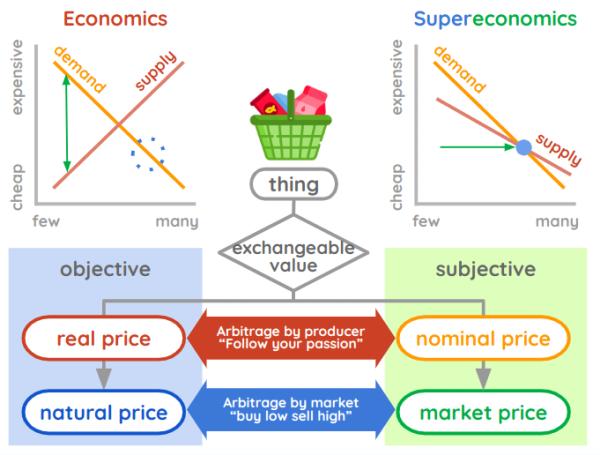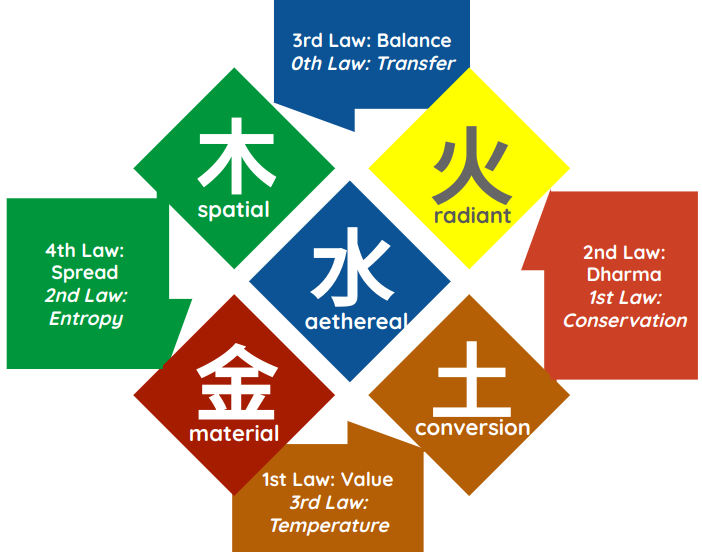The Four Laws Table
Table of Contents
Supereconomics classifies value into buyer-seller, and personal-societal, leading to 4 kinds of value.
| Supereconomics | Personal | Society |
|---|---|---|
| Subjective and Variable (Buyer’s perspective) | Nominal Price (value in currency) | Market Price (value to the buyer) |
| Objective and Natural or Invariable (Seller’s perspective) | Real Price (value in grain or labour) | Natural Price (value to the seller) |
Economics, on the other hand, has no concept of Real and Natural Price because it has no concept of society as an objective entity.
- It purposely rejects the importance of society because it enshrines selfishness, as a result of being dominated by the Negative Force.
- This Negative Force also facilitates division, crudity as materialism, war, conflict, racism, etc.
To pursue selfishness, Economics teaches:
- arbitrage
- profit maximization
- finance and money-only exchange
- private sensory pleasures.
As a result, it only has:
- economic value (nominal price)
- market value (market price)
| Economics | Personal | Society |
|---|---|---|
| Subjective and Variable | Nominal Price (value in currency) | Market Price (value to the buyer) |
Integrating Personal and Societal
Superphysics views a society as a metaphysical organism or oversoul that is made up of individual souls, just as a soul is a metaphysical organism made up of many selves.
I can only compare the soul to a republic with several members united by the reciprocal ties of government and subordination. This gives rise to other persons who propagate the same republic in the incessant changes of its parts. The same republic may change its members, laws, and constitutions.
David Hume
Supereconomics (Economic Superphysics) uses this to integrate the personal soul, as one’s gives-and-takes, with the social soul, as the gives-and-takes of the economic system.
This lets us summarize and organize our 4 prices into a pattern:
| Law | Price | Purpose |
|---|---|---|
| 1 | Nominal | Utilization - exposes the lack and the need |
| 2 | Real | Specialization - drives action to increase quality and quantity to deal with the lack |
| 3 | Natural | Balance - prevents the crashes that leads to a recurrence of lack |
| 4 | Market | Diffusion - spreads quality and quantity to address the lack |

| Law | Definition |
|---|---|
| 1 | Every thing in the universe has an existential value, otherwise it would not exist |
| 2 | Value is created to remove the lack in society |
| 3 | Natural |
| 4 | Market |
We find that it exactly matches the Law of Social Cycles of Supersociology:
| Cycle | Price |
|---|---|
| Worker | Nominal |
| Warrior | Real |
| Thinker | Natural |
| Trader | Market |
The Four Laws of Value
From here, we can connect Supereconomics with Supersociology by making them the Four Laws of Value.
| Law | Price | Meaning |
|---|---|---|
| 1 | Nominal | Everything in the universe has value |
| 2 | Real | Value is created to address lack |
| 3 | Natural | There must be balance in the creation and spread of value |
| 4 | Market | Value is spread through fair exchange |
Since we equate value to desire and desire in the physical domain is energy, then we can connect these 4 laws to the laws of thermodynamics:
| Supereconomics Law | Physics Thermodynamics Law |
|---|---|
| 1 - Nominal | 0 - Equilibrium (Wavelength) |
| 2 - Real | 1 - Conservation (Frequency or Density) |
| 3 - Natural | 3 - Absolute Zero (Amplitude) |
| 4 - Market | 2 - Entropy (Spread) |

How We Got the Four Laws from Adam Smith
We got the Four Laws by noticing a pattern in the maxims of Adam Smith in The Wealth of Nations which we distilled the maxims into 4 factors as:
- Demand
- Capital
- Supply
- Trade
We then compared these with the Four laws of Thermodynamics to fine-tune and harmonize the Four Laws of Supereconomics with:
- The Four Laws of thermodynamics of Physics
- The Four Cycles of Supersociology (which historically was the Hindu varna system)
The general industry of..society never can exceed what the capital of..society can employ (Law 2)… Every individual.. necessarily endeavours.. that his produce be of the greatest.. value (Law 2)… or to exchange for the greatest quantity either of money or of other goods (Law 4). The annual revenue of society..is the same thing with that exchangeable value (Law 4).
Adam Smith
Wealth of Nations Book 4, Chapter 2, Paragraphs 3-9
The quantity of industry.. is.. regulated by the annual demand so that the average annual produce is equal to the average annual consumption (Law 1).
Adam Smith
Wealth of Nations Book 1, Chapter 10, Paragraph 49
When we compute the quantity of industry.. we must always have regard to.. provisions, materials, and finished work. Money.. must always be deducted (Law 2)
Adam Smith
Wealth of Nations Book 2, Chapter 2, Paragraph 37
If the paper money never exceeds this value.. it can never exceed what the circulation of the country can.. absorb and employ (Law 3).
Adam Smith
Wealth of Nations Book 2, Chapter 2, Paragraph 60
So What’s the Four Laws of Value
The Four Laws of Value, like the other laws of Physics and Supersociology, arise from the wave-nature of the universe that flows in a certain way.
- This flow is called the Tao in Taoism
- This “certainess” is called the Dharma in Hinduism
Going against the flow leads to problems. And so the Four Laws prevents or solves economic problems or problems that involve exchangeable value.
A common personal problem is budgeting – people have no money to buy what they need or want.
Supereconomics uses the Fourth Law as fair exchange, with or without money, to reestablish a barter-credit system where people pay in their own goods or services by finding other people who would want their goods or services.
This requires people to value, and assign a value, to the work of other people and then trade for them by their own agreements, even without money.
The Four Laws extend to all economic phenomena (and problems). This makes it a tool for policy-making, whether for the personal, national, or global economy.
For example, violations of the Four Laws lead to economic problems and crises:
| Law | Violation Results in |
|---|---|
| First Law | Overspending, Budget Deficit, Poverty Cycle, Unemployment |
| Second Law | Valuation Errors, Bubbles, Overinvestment, Underinvestment |
| Third Law | Inequality, Moral Hazard, Financial Crises, Illicit goods |
| Fourth Law | Inflation, Recessions, Trade War, Crypto Scams |
Updates
| 4/2017 | added Economics value matrix |
|---|---|
| 8/2020 | overhauled to match Superphysics |
| 7/2021 | overhauled to base everything on the four laws |
| 2/2022 | Added the four classes (Worker, Warrior, Philosopher, Merchant) onto the four laws |
| 3/2024 | Put the 4th Law as the 2nd to explain the priorness of politics over economics, or Supersociology over Supereconomics |
| 8/2024 | Put the 4th Law as the 3rd Law after connecting it again with Thermodynamics |
| 7/2025 | Fixed order of Thermodynamics to match video |